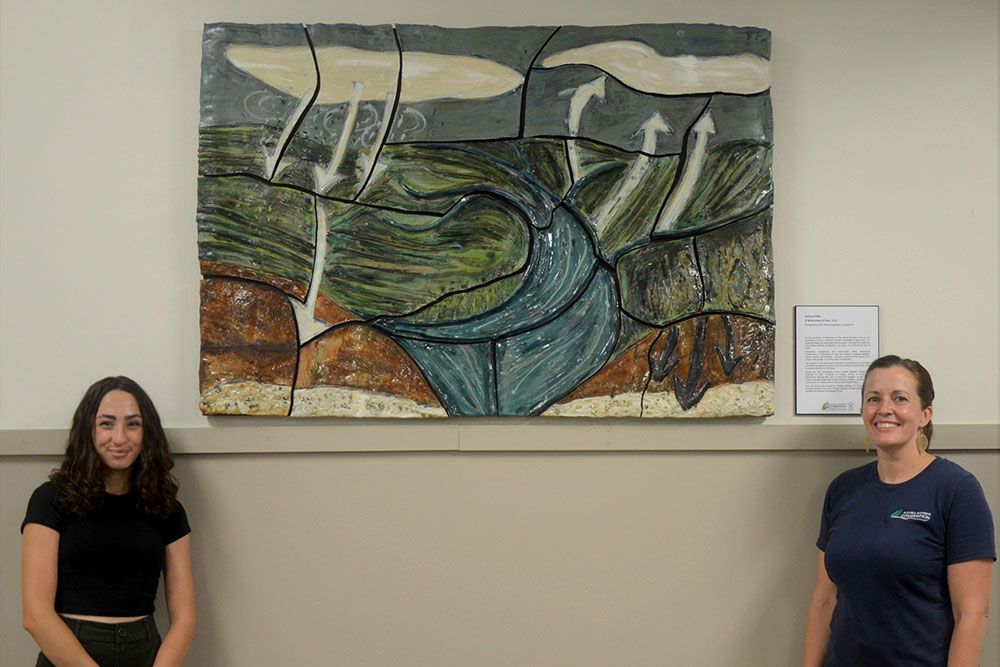Art promotes protecting watershed

New artwork installed at Arkona Lions Museum to help visitors learn about watersheds and protecting soil, water
Thousands of visitors to Arkona Lions Museum and Information Centre will know more about watersheds, and protecting them, thanks to the installation of a piece of art called A Watershed of Clay.
“We all need to work together to protect soil and water and we are all a piece of the puzzle,” said Nina Sampson, Conservation Educator with Ausable Bayfield Conservation. “Art moves us and inspires us to look at our landscape in a new way. Visitors to the museum will learn about local watersheds through this artwork and we hope it will inspire them to take positive actions to protect them.”
Ausable Bayfield Conservation Authority (ABCA) staff installed the art, at the museum located in Rock Glen Conservation Area (RGCA) in Arkona, in August. Artist Andrea Piller created the ceramic sculptural piece. The artwork is 57 inches (almost five feet) wide and 36 inches (more than three feet) tall. It weighs about 100 pounds. Piller’s ceramic sculptural artwork is inspired by Ontario’s land, sky, and shorelines.
The art project was possible thanks to the work of researcher Hannah May. She is a Masters student and Food from Thought 2020 Highly Qualified Personnel (HQP) Scholar working under the supervision of Dr. Andrew Binns and Dr. Jana Levison. As a University of Guelph School of Engineering researcher, she is doing research at the Ontario Ministry of the Environment, Conservation and Parks’ Integrated Water and Climate Research Station located in Parkhill Creek. May is researching the transportation of nutrients (such as phosphorus and nitrogen) in Great Lakes Basin watersheds where clay soil is common.
Surface runoff, drainage, and erosion can lead to excess nutrient enrichment in the Great Lakes. This can impact the abundance and diversity of species in the lake and could add to toxic algal blooms and eutrophication, which is harmful to human and aquatic health. There is a need to manage water running off of land and to develop strategies to reduce nutrient loss to the Great Lakes as our climate changes, according to May. She said there is a need to understand how watersheds work, how nutrients can reach the lake, and how we can reduce these impacts. The artwork helps to teach the public about nutrient movement in a watershed and the need to manage and reduce those impacts.
To learn more visit:
Artist Andrea Piller; researcher Hannah May; and conservation educator Nina Sampson worked together to develop this clay artwork. They wanted to provide a message about the science of watersheds but also to spark curiosity and get viewers to think about how water, watersheds, and people are connected. The mosaic clay tiles show the water cycle and landscape features. Arrows show how runoff; streamflow; groundwater; evaporation; and rain, snow, and other precipitation interact. The project team decided on clay as a material as clay soil is a key part of the landscape along Lake Huron’s southeast shore. Clay has been used in local home construction, for instance.
May said the artwork project has been a fascinating one. “This has been a great chance to connect with people outside my field, to build relationships, and to communicate concepts in a simple and creative way to new audiences,” she said.
This art project was funded by Guelph Institute for Environmental Research (GIER) and the Food from Thought program (a $76.6-million grant from the Canada First Research Excellence Fund). The creation of this artwork is part of an arts-based knowledge mobilization project. GIER has a vision to break down barriers among disciplinary silos and bring the arts, the sciences, the humanities, and the engineering together to tackle complex environmental problems.
PHOTO: A WATERSHED OF CLAY ARTWORK INSTALLED AT MUSEUM IN ARKONA: A new piece of artwork, called A Watershed of Clay, was installed at Arkona Lions Museum and Information Centre, at Rock Glen Conservation Area in Arkona, in August. Shown with the artwork, left to right in photo, are University of Guelph School of Engineering researcher Hannah May; and Nina Sampson, Conservation Educator with Ausable Bayfield Conservation Authority (ABCA). The clay ceramic art was created by artist Andrea Piller. This art and science project was funded by Guelph Institute for Environmental Research (GIER) and the Food from Thought program.
